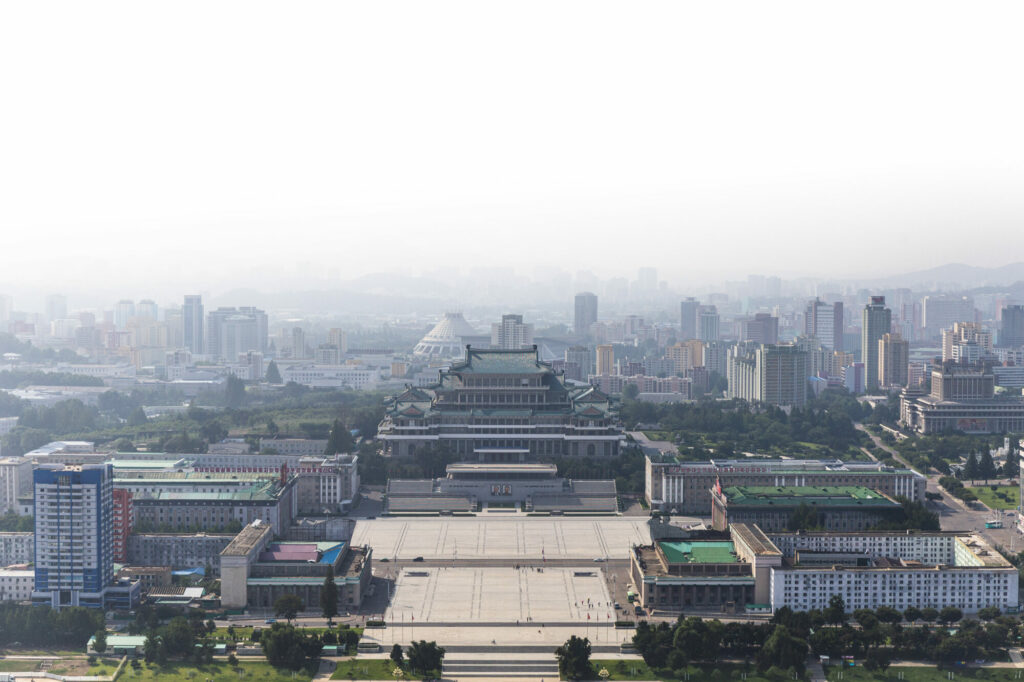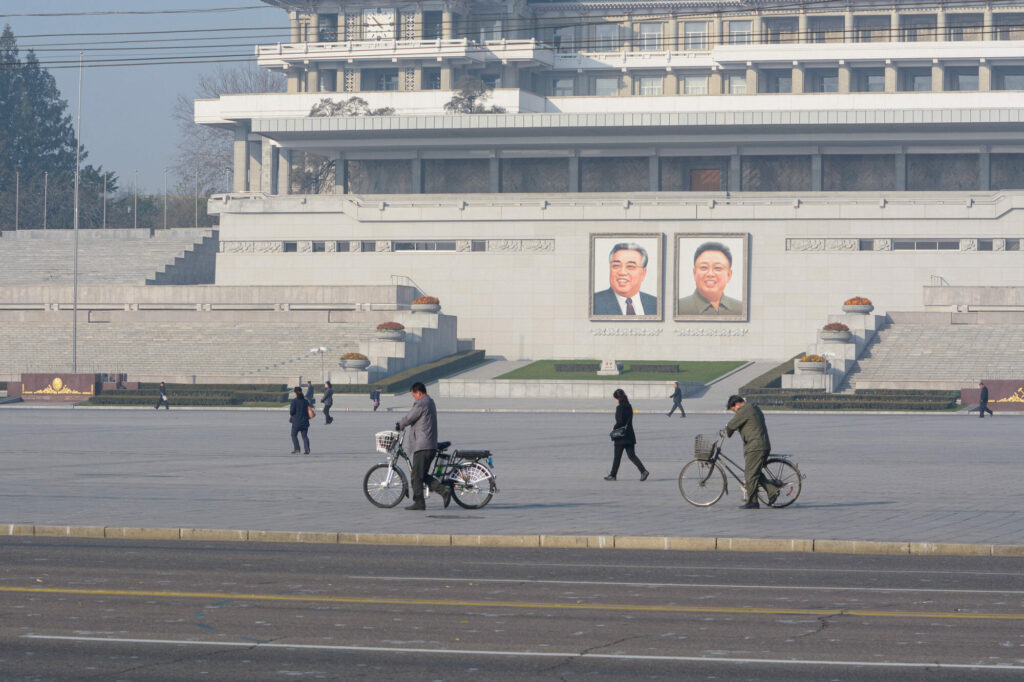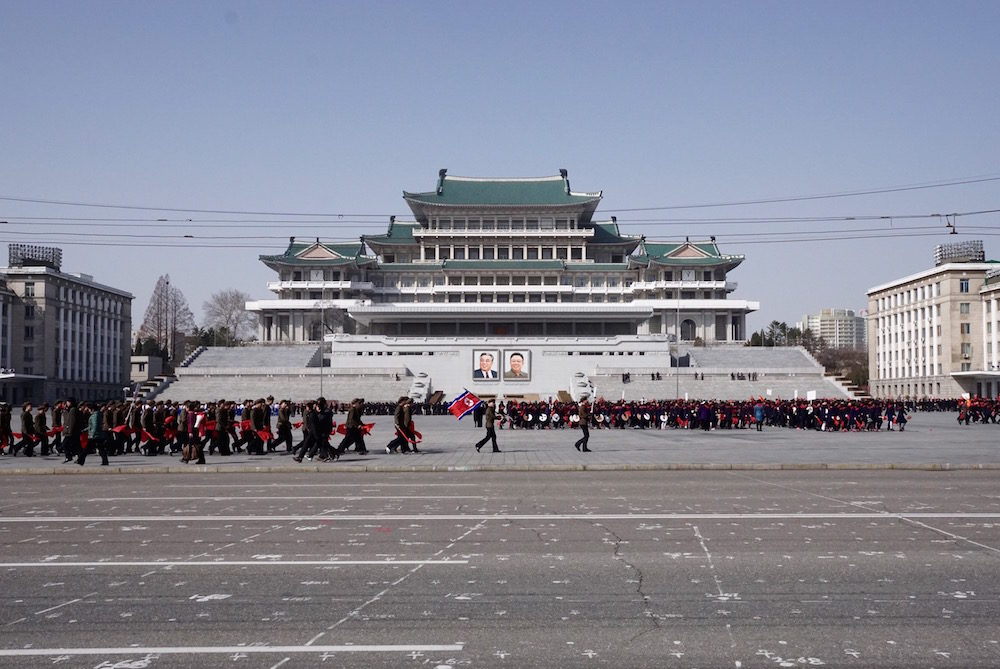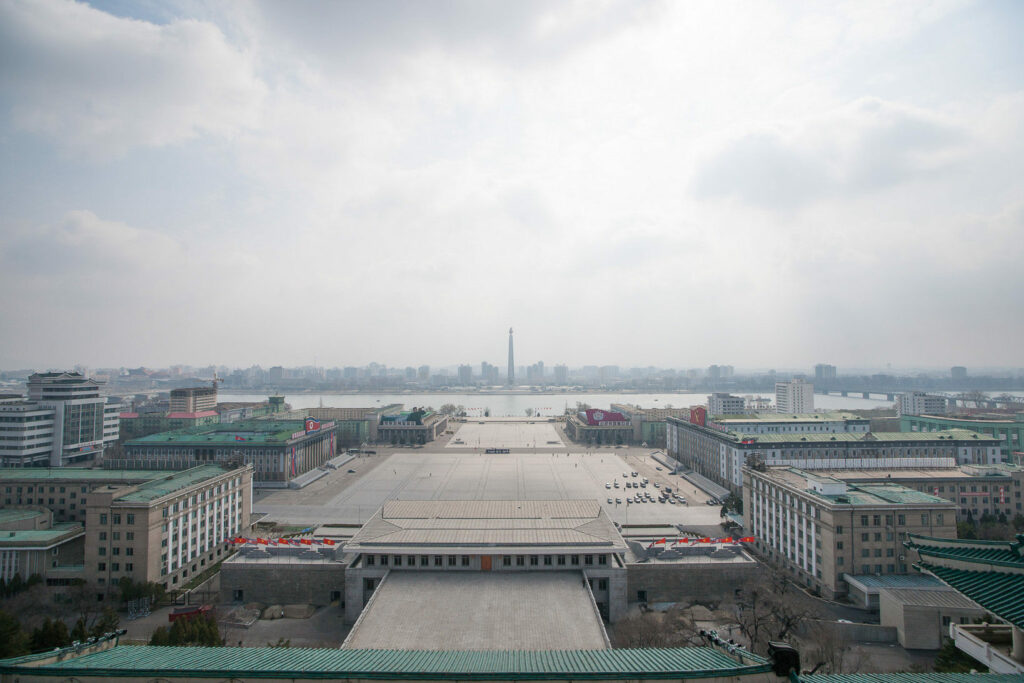Overview
Kim Il Sung Square is the central square of North Korea’s capital, Pyongyang. It was completed in August 1954 as part of post-war reconstruction efforts and is named after North Korea’s founder and Eternal President Kim Il Sung.

At the time of its inauguration, Kim Il Sung Square covered 36,000m² but has since been extended to cover 75,000m². It’s the 37th largest public square in the world and is paved in granite blocks.
Kim Il Sung Square sits on the western side of the Taedong River and is bisected into a lower and upper half by Sungri (Victory) Street.
What’s it used for?
As the most prominent public square in North Korea, Kim Il Sung Square is host to important political and celebratory events. You’ve almost certainly seen Kim Il Sung Square on TV, as North Korea’s military parades broadcast internationally are held right here on location!
Mass rallies, such as those after successful missile tests, and torchlight processions on special anniversaries have historically taken place in Kim Il Sung Square. Kim Il Sung Square is also among Pyongyang’s major sites for student mass dances, alongside the plazas of the Tower of the Juche Idea, the Monument to Party Founding, the Arch of Triumph, the April 25th House of Culture, and the Pyongyang Indoor Stadium.
During winter, Kim Il Sung Square hosts New Year’s events highlighted by concert performances and light shows and is the perfect spot to watch fireworks displays over the Juche Tower. Folk events for children are also a mainstay in Kim Il Sung Square on New Year’s Day, and the annual Ice Sculpture Festival takes place here.

On an average day, you’ll spot people walking through the square, rollerskating, or walking their dogs, but unlike public squares elsewhere it’s not a place you’ll find hotdog stands, human statue buskers, or souvenir hustles lining the edges!
What surrounds the square?
The instinctive head of Kim Il Sung Square does not face north but west. With your back to the Taedong River, the buildings surrounding Kim Il Sung Square in the lower half are as follows:
Grand Peoples Study House (ahead): North Korea’s national library holding 30 million books, the heart of study on the Juche ideology. This iconic building is symmetrical to the Tower of the Juche Idea across the Taedong River, symbolizing the direct link between the people and the Juche ideology.
Korean Central Art Gallery (left): Opened in 1954, this gallery and museum is a chronological timeline of Korean art from primitive paintings of the 4th century right up to the socialist-realist artworks and sculptures of today.
Korean Central History Museum (right): Opened in 1945, this is an exhibit of historical relics dating back to ancient Korea, through the ‘Three Kingdoms’, Koryo and Choson Dynasties, and into the modern age. Displays include decorated pottery, Buddhist statues, unearthed tools and weapons, and photographs from inside historical tombs which are otherwise inaccessible.
Taedong River & Tower of the Juche Idea (behind): Kim Il Sung Square is on the banks of the Taedong River. There’s a popular bike path along the promenade here, and it’s a prime spot for photographs. There’s a line of flag poles which colour up on the holidays. Across the river is the Tower of the Juche Idea, perfectly symmetrical to the square and the Grand People’s Study House.
The upper half of Kim Il Sung Square is flanked by high-profile government ministries, and outside of extraordinary circumstances, foreigners are not permitted to roam this side.
Interesting facts

- Kim Il Sung Square is often marked temporarily with dots and numbers in grid layouts indicating the choreography and marching steps for parades
- Kim Il Sung Square is kilometer zero of North Korea’s road system, from where distances are measured
- There’s an Austrian coffee shop, Vienna Cafe (Ryongwang Coffee Shop) on the building edge of the Korean Central History Museum. Perhaps the most unexpected place for a foreign coffee shop ever!
- The parade stand, from where North Korea’s leadership watch parades in Kim Il Sung Square, sits in front of the Grand People’s Study House and is adorned by large portraits of President Kim Il Sung and Chairman Kim Jong Il. Military parades happen far more infrequently than foreign media would indicate, typically only on jubilee years of national holidays
- Portraits of Karl Marx and Vladimir Lenin were in Kim Il Sung Square until relatively recently, removed in October 2012. Marxism–Leninism lost traction to the Korean-style of socialism, Juche. The only portraits in Kim Il Sung Square are now those on the parade stand.
- Since 2017, solar-powered boats run from the Juche Tower and disembark at Kim Il Sung Square to shuttle locals across for work
Visiting on Our Tours
If your tour with us includes Pyongyang, you’ll visit Kim Il Sung Square. It’s ideal to visit early in the tour to orientate yourself with the layout of the capital, and to learn of the importance of symbolism and ideology in the North Korean psyche.

Kim Il Sung Square can be visited anytime and will begin at the parking lot on the east alongside the Taedong River. We’ll spend enough time to explore the square and take photos before taking a city walk to the nearby Foreign Languages Bookshop. Our cycling tours of Pyongyang include Kim Il Sung Square, and you’ll stop here on walks along the river.
The best views of Kim Il Sung Square can be had from the viewing platform on the Grand People’s Study House or from atop the Tower of the Juche Idea, both mainstays on our itineraries in Pyongyang.
